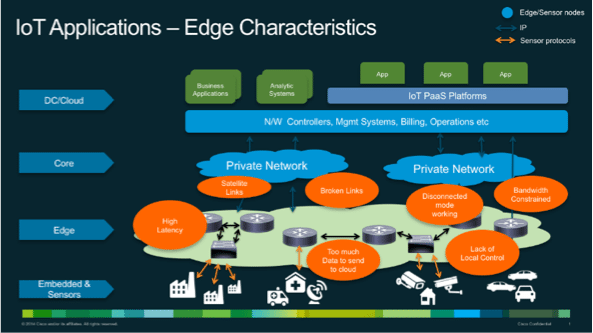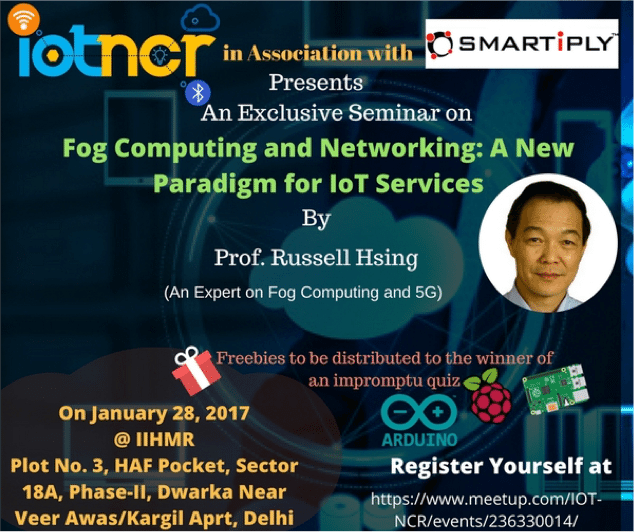IoT/IoE/M2M all point towards a very exciting area of evolving technologies which exhibit potential to change how we live, work, operate, manufacture, consume and deliver things. Basically IoT means a sensor or a device capturing some information and sending it to a server or cloud over the internet back-haul. Later on that information is processed, analyzed and consumed to take action or make meaningful derivations. But an important question is do we need to transmit all data capture at the sensor/device level to the cloud/central server? NO. Do we have time sensitive information and need to make really quick decisions at the edge layer? Yes, in some use cases.
Cisco says that today’s CLOUD is not designed for the Volume, Variety, and Velocity of the data that IoT generates. So what do we need a solution that reduce reliance on cloud and also help make the edge of the IoT network smarter, efficient and scale-able.
Fog computing or fog networking also known as fogging is the answer. It is an architecture that uses one or more collaborative multitude of end user clients or near-user edge devices to carry out a substantial amount of storage, communication, control, configuration, measurement and management. Fog becomes a complimentary solution to the cloud to support managing vast amount of data generated by IoT devices and offer solution to need of minimizing latency, conserving network bandwidth, reducing cost, protecting sensitive  data/information, and operating reliably. Cisco described the edge characteristics very nicely. What I derive is that FOG/Edge computing can support the system to run in case of major link failures or connectivity losses and hence make the system more reliable and robust for mission critical applications.
data/information, and operating reliably. Cisco described the edge characteristics very nicely. What I derive is that FOG/Edge computing can support the system to run in case of major link failures or connectivity losses and hence make the system more reliable and robust for mission critical applications.
Let’s take simple example of surveillance, where a video or photo captured by a camera is transmitted over the internet and then analyzed for decision making. What if we build small intelligence at the device layer (of course there is a trade off the power requirement) , where in it makes quick decision and filter out not so useful video or images. We need machine learning coupled with artificial intelligence and some business logic encoded in the device and executed on every capture. In the same scenario we sometime also need to make decisions in milliseconds and cannot wait for the round trip to the cloud.
Fog computing is an exciting area to deep dive into and on the same topic I would draw your attention to the event jointly organized by IOT-NCR and SmartiPly on 28th Jan 10 am to 1 pm in Delhi, India (Plot No. 3, HAF Pocket, Sector 18A, Phase-II, Dwarka Near Veer Awas/Kargil Aprt, Delhi, IN). Prof. Russell Hsing (Board of Director for the OpenFog Consortium), a Fog computing expert will deliver seminar and take questions. Event will also have Q&A and Quiz with Pi and Arduino giveaways to the winner. REGISTER HERE.

As per the organisers the event will have a quiz round at the end of the event where participants will answers some questions based on IOT & Fog Computing. A Q&A round will proceed after the event. The event is a good chance for networking over a cup of coffee with the likeminded people and also know about the upcoming trends.
About IOT-NCR: IOT NCR is an open community for people interested in IoT and M2M. From a group of 10 people, it has grown to a size-able chunk of 2100+ member and is the 2nd largest IoT community in India. It consist of entrepreneurs, working professionals, students, researchers, investors, evangelists, etc, who come together to learn, deliberate, innovate and discuss about IoT. These enthusiasts attend workshops/talks, work together on IoT projects, share equipment and resources, build IoT solutions and startups, and generally stay updated about the latest developments in the connected world.
About Prof. Russell Hsing: He graduated from the National Chiao Tung University (Taiwan) in 1970, and received his M.S. and Ph.D (in EE) from the University of Rhode Island in 1974 & 1977. He has accumulated 36 years in the telecom and ICT industry. His research interests are in the areas of Wireless 5G, Internet of Vehicles (IoV), HDSL/ADSL, Visual Communications, Broadband Wireless Technologies and Networking Systems, Vehicular Networks and Telematics Applications, and Emerging Services Applications, and Technology Entrepreneurship. He has five patents granted in US.
Link for registration- Click here






Wow!!